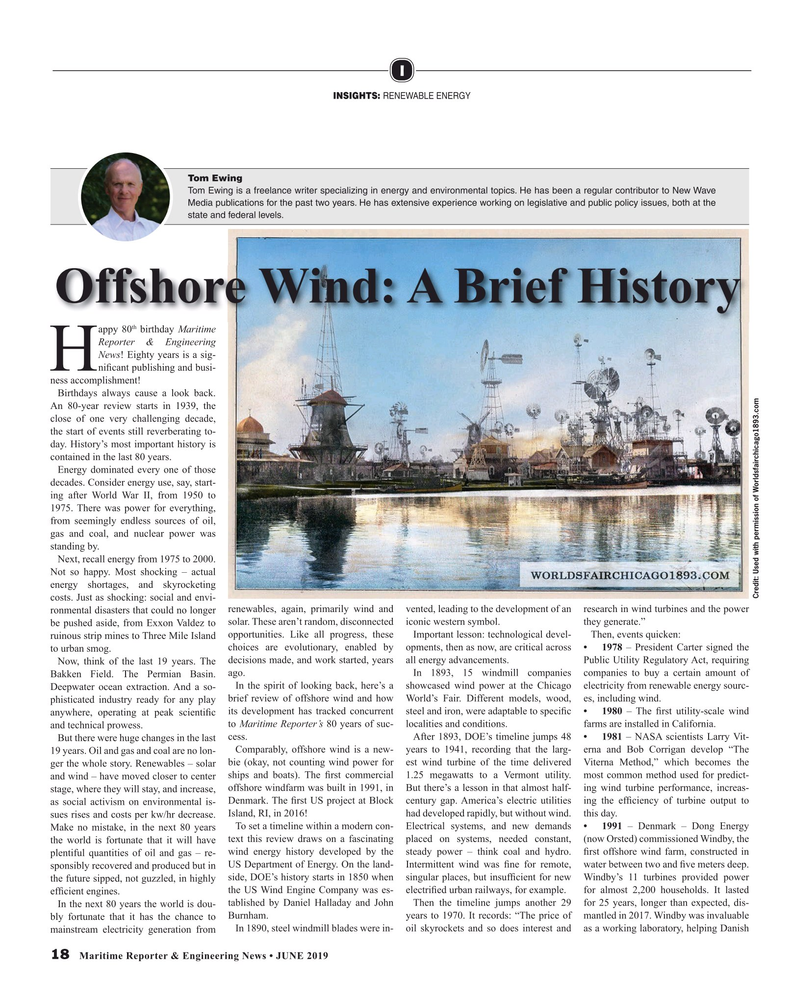
Page 18: of Maritime Reporter Magazine (June 2019)
80th Anniversary World Yearbook
Read this page in Pdf, Flash or Html5 edition of June 2019 Maritime Reporter Magazine
I
INSIGHTS: RENEWABLE ENERGY
Tom Ewing
Tom Ewing is a freelance writer specializing in energy and environmental topics. He has been a regular contributor to New Wave
Media publications for the past two years. He has extensive experience working on legislative and public policy issues, both at the state and federal levels.
Offshore Wind: A Brief History th appy 80 birthday Maritime
Reporter & Engineering
News! Eighty years is a sig-
Hni? cant publishing and busi- ness accomplishment!
Birthdays always cause a look back.
An 80-year review starts in 1939, the close of one very challenging decade, the start of events still reverberating to- day. History’s most important history is contained in the last 80 years.
Energy dominated every one of those decades. Consider energy use, say, start- ing after World War II, from 1950 to 1975. There was power for everything, from seemingly endless sources of oil, gas and coal, and nuclear power was standing by.
Next, recall energy from 1975 to 2000.
Not so happy. Most shocking – actual energy shortages, and skyrocketing
Credit: Used with permission of Worldsfairchicago1893.com costs. Just as shocking: social and envi- ronmental disasters that could no longer renewables, again, primarily wind and vented, leading to the development of an research in wind turbines and the power be pushed aside, from Exxon Valdez to solar. These aren’t random, disconnected iconic western symbol. they generate.” ruinous strip mines to Three Mile Island opportunities. Like all progress, these Important lesson: technological devel- Then, events quicken: choices are evolutionary, enabled by opments, then as now, are critical across • 1978 – President Carter signed the to urban smog.
Now, think of the last 19 years. The decisions made, and work started, years all energy advancements. Public Utility Regulatory Act, requiring
Bakken Field. The Permian Basin. ago. In 1893, 15 windmill companies companies to buy a certain amount of
In the spirit of looking back, here’s a showcased wind power at the Chicago electricity from renewable energy sourc-
Deepwater ocean extraction. And a so- phisticated industry ready for any play brief review of offshore wind and how World’s Fair. Different models, wood, es, including wind.
anywhere, operating at peak scienti? c its development has tracked concurrent steel and iron, were adaptable to speci? c • 1980 – The ? rst utility-scale wind to Maritime Reporter’s 80 years of suc- localities and conditions. farms are installed in California.
and technical prowess.
But there were huge changes in the last cess. After 1893, DOE’s timeline jumps 48 • 1981 – NASA scientists Larry Vit-
Comparably, offshore wind is a new- years to 1941, recording that the larg- erna and Bob Corrigan develop “The 19 years. Oil and gas and coal are no lon- ger the whole story. Renewables – solar bie (okay, not counting wind power for est wind turbine of the time delivered Viterna Method,” which becomes the and wind – have moved closer to center ships and boats). The ? rst commercial 1.25 megawatts to a Vermont utility. most common method used for predict- stage, where they will stay, and increase, offshore windfarm was built in 1991, in But there’s a lesson in that almost half- ing wind turbine performance, increas-
Denmark. The ? rst US project at Block century gap. America’s electric utilities ing the ef? ciency of turbine output to as social activism on environmental is- sues rises and costs per kw/hr decrease. Island, RI, in 2016! had developed rapidly, but without wind. this day.
To set a timeline within a modern con- Electrical systems, and new demands • 1991 – Denmark – Dong Energy
Make no mistake, in the next 80 years the world is fortunate that it will have text this review draws on a fascinating placed on systems, needed constant, (now Orsted) commissioned Windby, the wind energy history developed by the steady power – think coal and hydro. ? rst offshore wind farm, constructed in plentiful quantities of oil and gas – re- sponsibly recovered and produced but in US Department of Energy. On the land- Intermittent wind was ? ne for remote, water between two and ? ve meters deep. the future sipped, not guzzled, in highly side, DOE’s history starts in 1850 when singular places, but insuf? cient for new Windby’s 11 turbines provided power the US Wind Engine Company was es- electri? ed urban railways, for example. for almost 2,200 households. It lasted ef? cient engines.
tablished by Daniel Halladay and John Then the timeline jumps another 29 for 25 years, longer than expected, dis-
In the next 80 years the world is dou- bly fortunate that it has the chance to Burnham. years to 1970. It records: “The price of mantled in 2017. Windby was invaluable
In 1890, steel windmill blades were in- oil skyrockets and so does interest and as a working laboratory, helping Danish mainstream electricity generation from 18 Maritime Reporter & Engineering News • JUNE 2019
MR #6 (18-25).indd 18 6/3/2019 11:22:40 AM

 17
17

 19
19
